Vegetation Dynamics and Associated Driving Forces in Eastern China during 1999–2008
Abstract
:1. Introduction
2. Methodology
2.1. Study Area
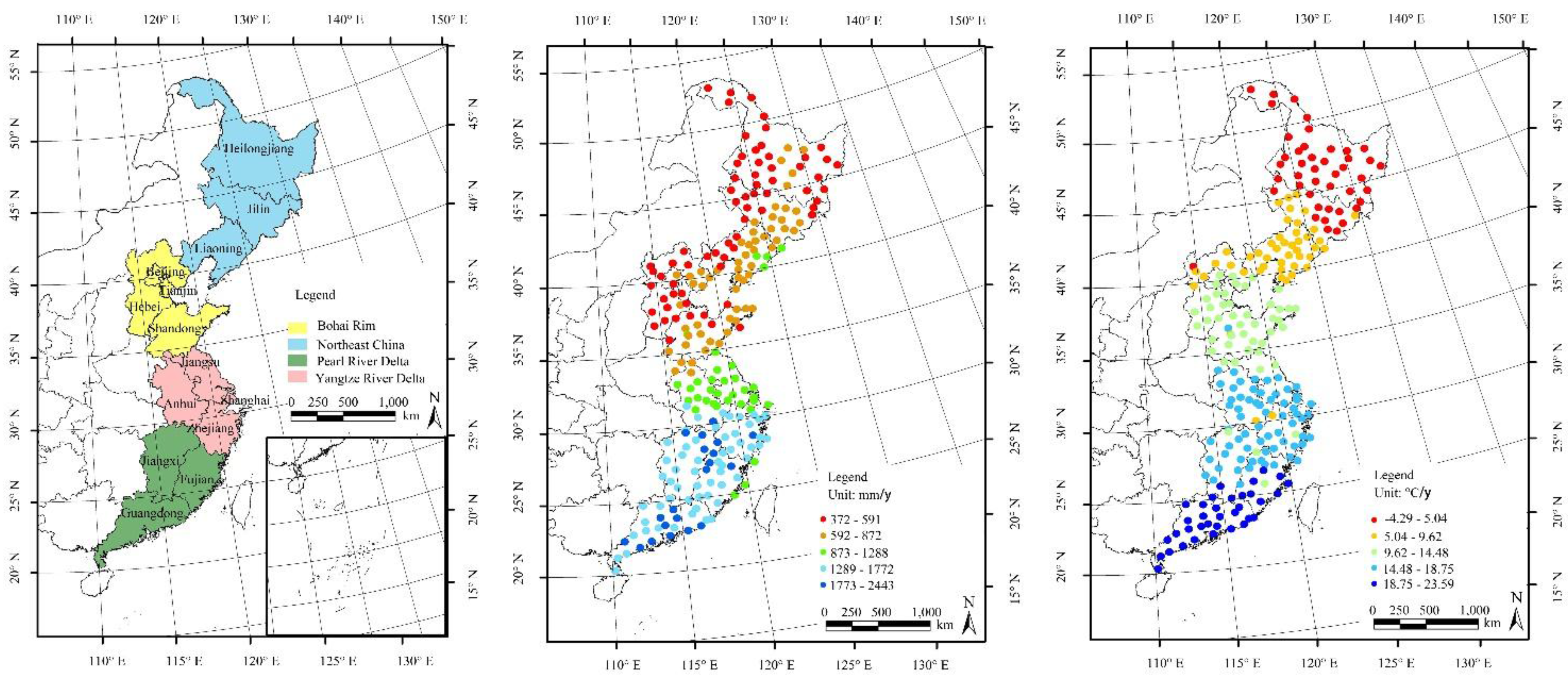
2.2. Data Sources and Processing
2.2.1. NDVI Composite
2.2.2. Climate Data Selection
2.2.3. DMSP/OLS Data Identification
| 1999 | 2008 | |||||
|---|---|---|---|---|---|---|
| Province | Threshold | Area Extracted (km2) | Error Percentage (%) | Threshold | Area Extracted (km2) | Error Percentage (%) |
| Heilongjiang | 8 | 14,789 | 2.83 | 16 | 15,136 | 1.74 |
| Jilin | 6 | 8,887 | −13.94 | 11 | 10,325 | −2.97 |
| Liaoning | 8 | 13,590 | 4.06 | 16 | 14,158 | 1.30 |
| Hebei | 10 | 17,130 | 3.85 | 19 | 18,058 | 0.82 |
| Beijing | 36 | 2,651 | 0.45 | 55 | 3,336 | −1.07 |
| Tianjin | 19 | 3,045 | 0.98 | 37 | 3,699 | 0.76 |
| Shandong | 8 | 23,755 | 7.15 | 19 | 25,493 | 1.62 |
| Jiangsu | 10 | 15,614 | −4.51 | 34 | 19,436 | 1.00 |
| Shanghai | 47 | 2,098 | −1.29 | 58 | 2,785 | 10.34 |
| Zhejiang | 14 | 7,475 | −2.47 | 37 | 10,412 | 0.08 |
| Fujian | 14 | 5,275 | 0.07 | 27 | 6,371 | −1.20 |
| Guangdong | 22 | 15,225 | −0.56 | 38 | 17,966 | 0.46 |
| Anhui | 4 | 15,444 | −1.98 | 10 | 15,778 | −5.01 |
| Jiangxi | 4 | 8,289 | −2.84 | 10 | 9,141 | −3.73 |
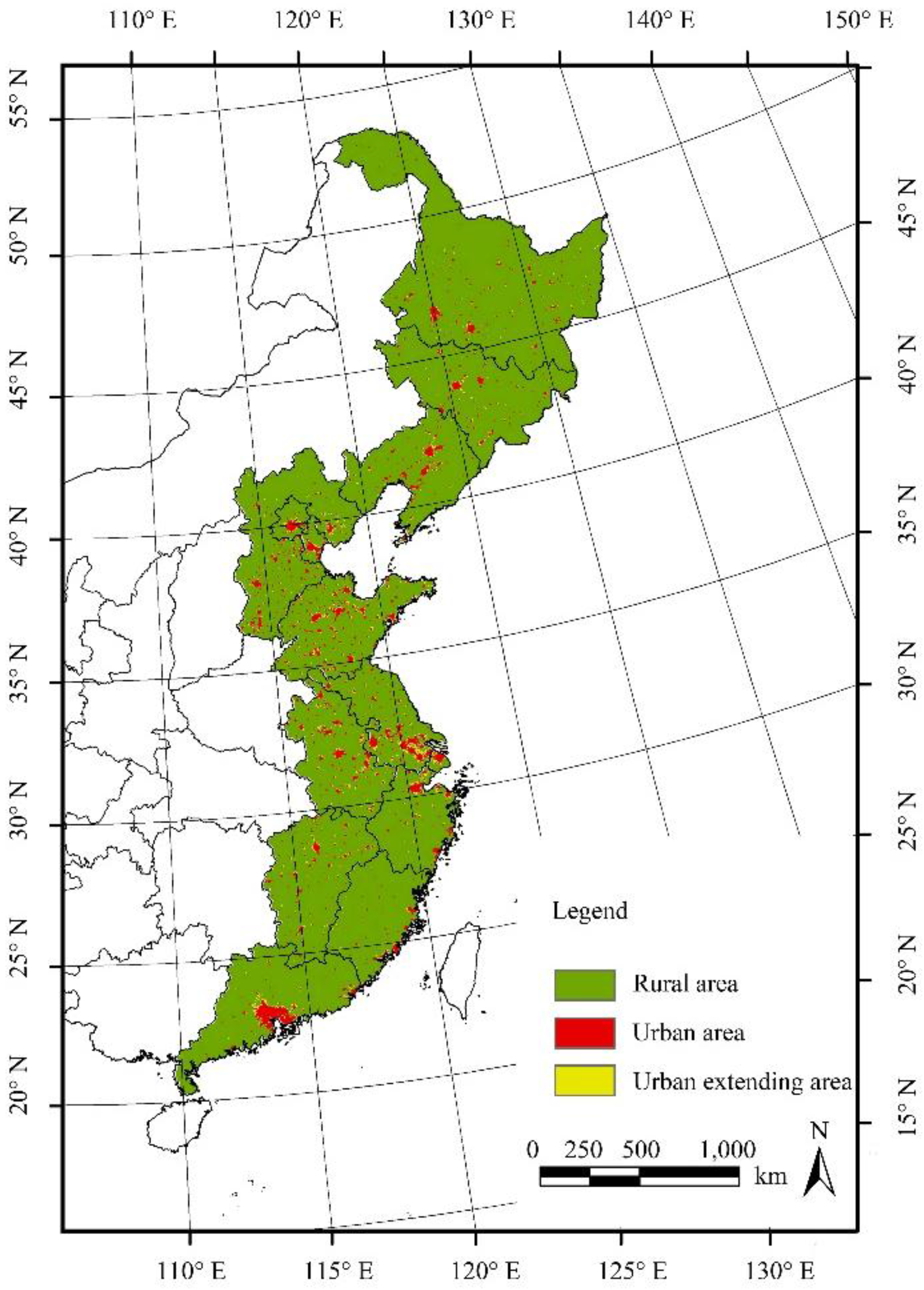
2.3. Trend Analysis of Vegetation Dynamics
2.4. Partial Correlation Analysis of Driving Forces
3. Result
3.1. Trends in NDVI Change
| Region | Fitting Equation | p Value |
|---|---|---|
| Eastern China | y = 0.0032x − 5.031 | 0.017 |
| Northeast China | y = 0.0049x − 4.908 | 0.079 |
| Bohai Rim | y = 0.0031x − 6.167 | 0.034 |
| Yangtze River Delta | y = 0.0066x − 12.627 | 0.000 |
| Pearl River Delta | y = 0.0029x − 6.209 | 0.082 |

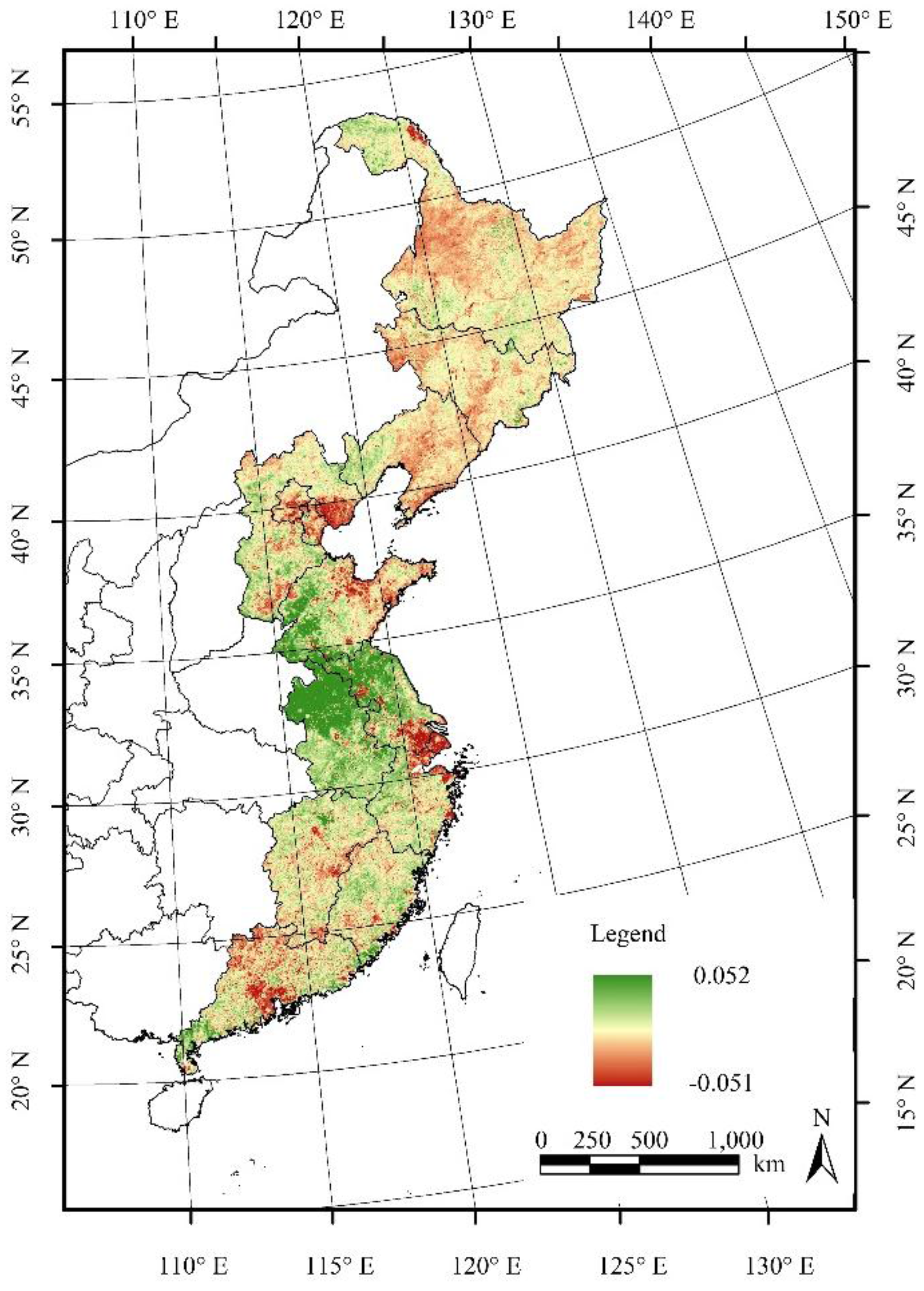
3.2. Vegetation Change and Climatic Factors
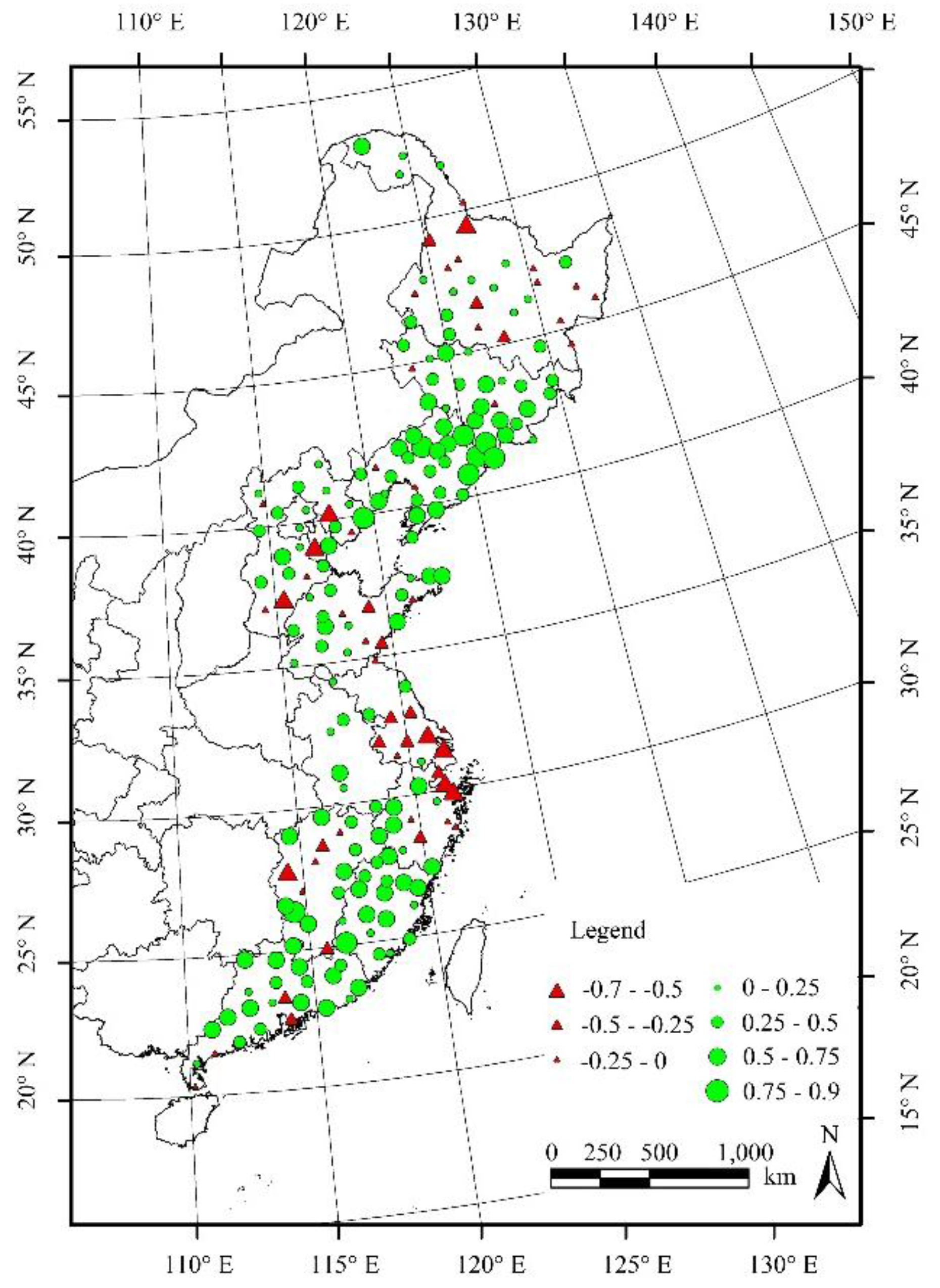
| Region | Negative Correlation | Positive Correlation | Sum | |||
|---|---|---|---|---|---|---|
| No. | % | No. | % | No. | % | |
| Eastern China | 57 | 27.14 | 153 | 72.86 | 210 | 100 |
| Northeast China | 19 | 24.05 | 60 | 75.95 | 79 | 100 |
| Bohai Rim | 12 | 27.91 | 31 | 72.09 | 43 | 100 |
| Yangtze River Delta | 16 | 53.33 | 14 | 46.67 | 30 | 100 |
| Pearl River Delta | 10 | 17.24 | 48 | 82.76 | 58 | 100 |

| Region | Negative Correlation | Positive Correlation | Sum | |||
|---|---|---|---|---|---|---|
| No. | % | No. | % | No. | % | |
| Eastern China | 100 | 47.62 | 110 | 52.38 | 210 | 100 |
| Northeast China | 42 | 53.16 | 37 | 46.84 | 79 | 100 |
| Bohai Rim | 23 | 53.49 | 20 | 46.51 | 43 | 100 |
| Yangtze River Delta | 6 | 20 | 24 | 80 | 30 | 100 |
| Pearl River Delta | 29 | 50 | 29 | 50 | 58 | 100 |
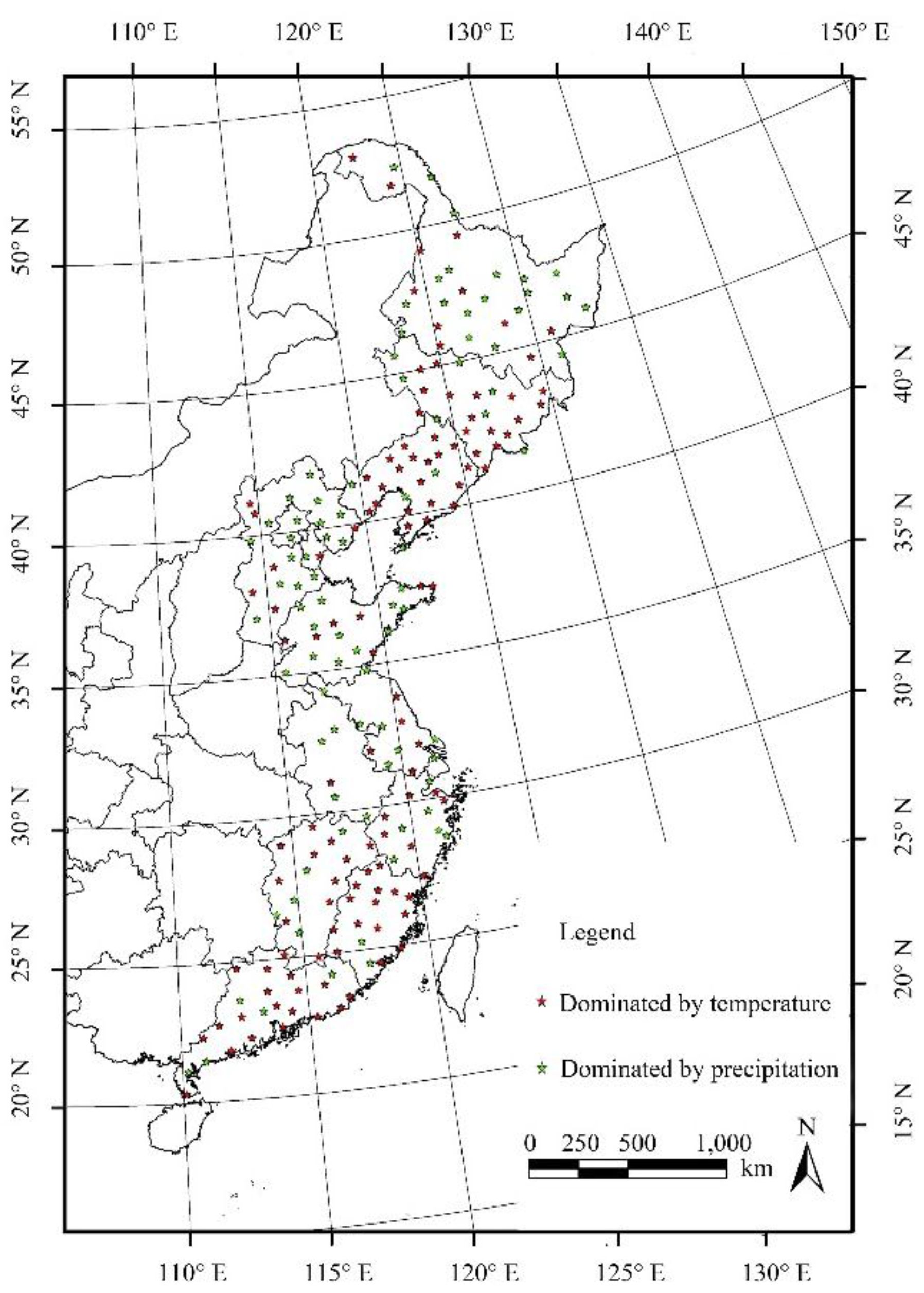
| Region | Temperature Dominated | Precipitation Dominated | Sum | |||
|---|---|---|---|---|---|---|
| No. | % | No. | % | No. | % | |
| Eastern China | 120 | 57.14 | 90 | 42.86 | 210 | 100 |
| Northeast China | 48 | 60.76 | 31 | 39.24 | 79 | 100 |
| Bohai Rim | 14 | 32.56 | 29 | 67.44 | 43 | 100 |
| Yangtze River Delta | 12 | 40 | 18 | 60 | 30 | 100 |
| Pearl River Delta | 46 | 79.31 | 12 | 20.69 | 58 | 100 |
3.3. Vegetation Change in Urban and Rural Areas
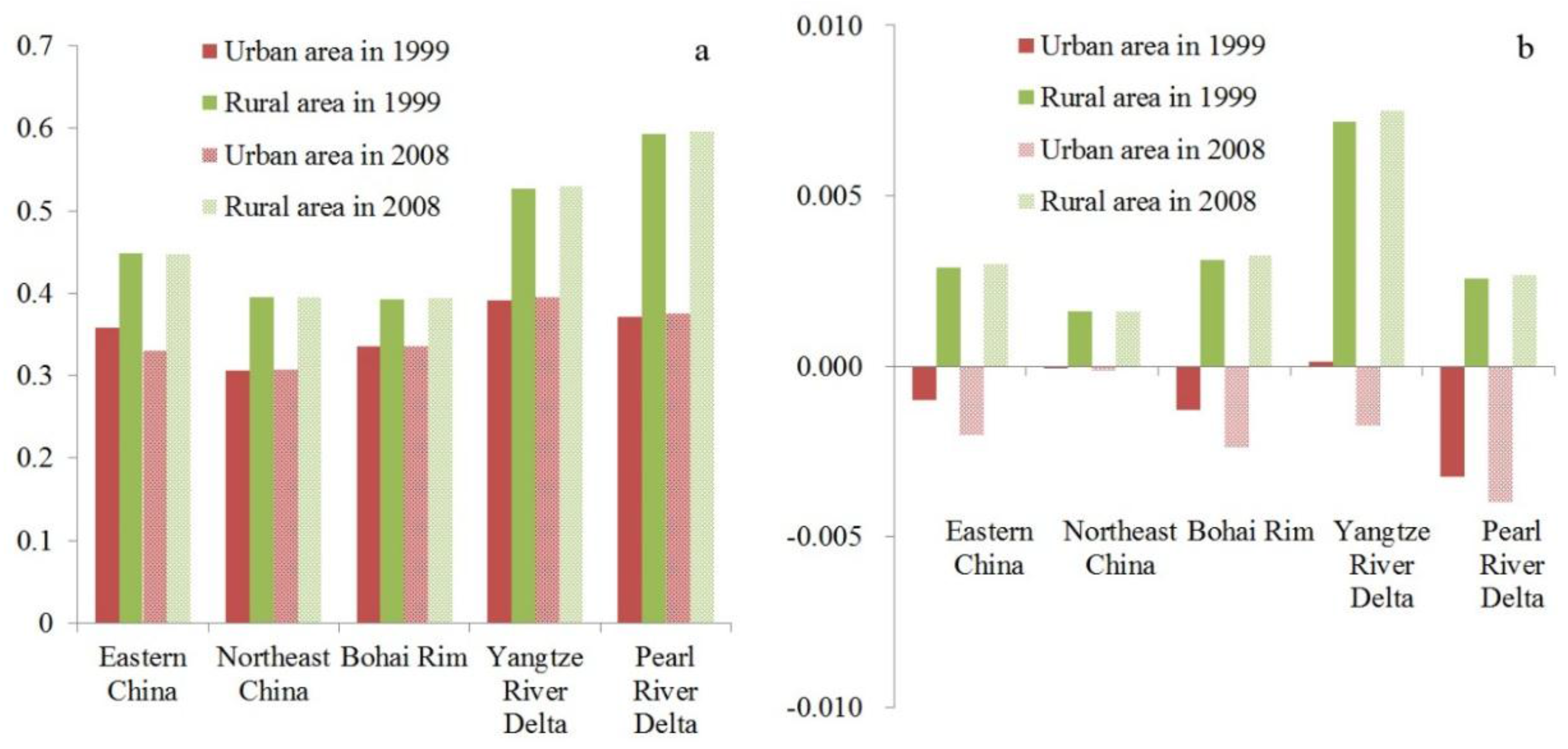
4. Discussion
4.1. Effects of Urbanization on NDVI
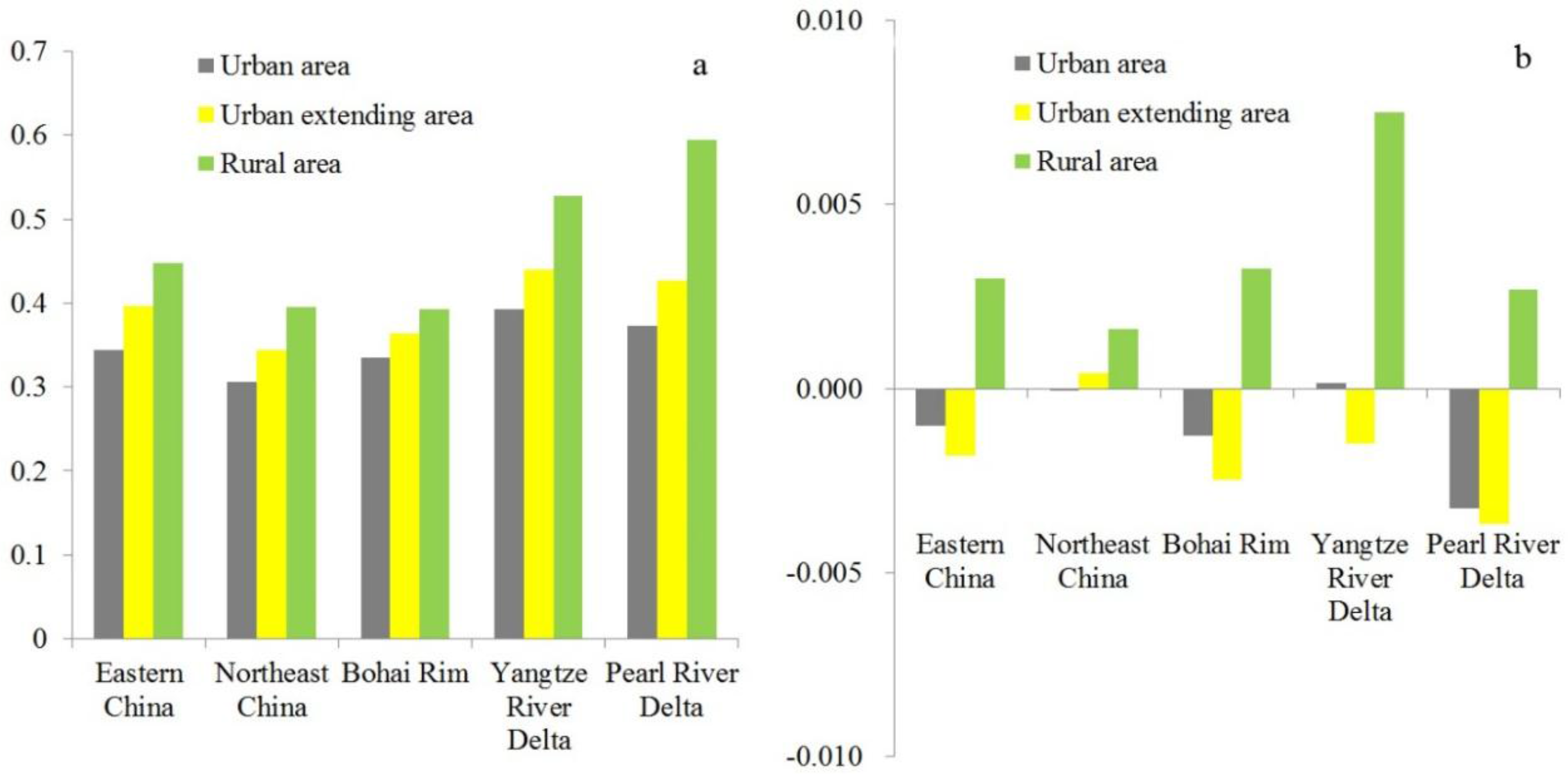
4.2. Method Comparison
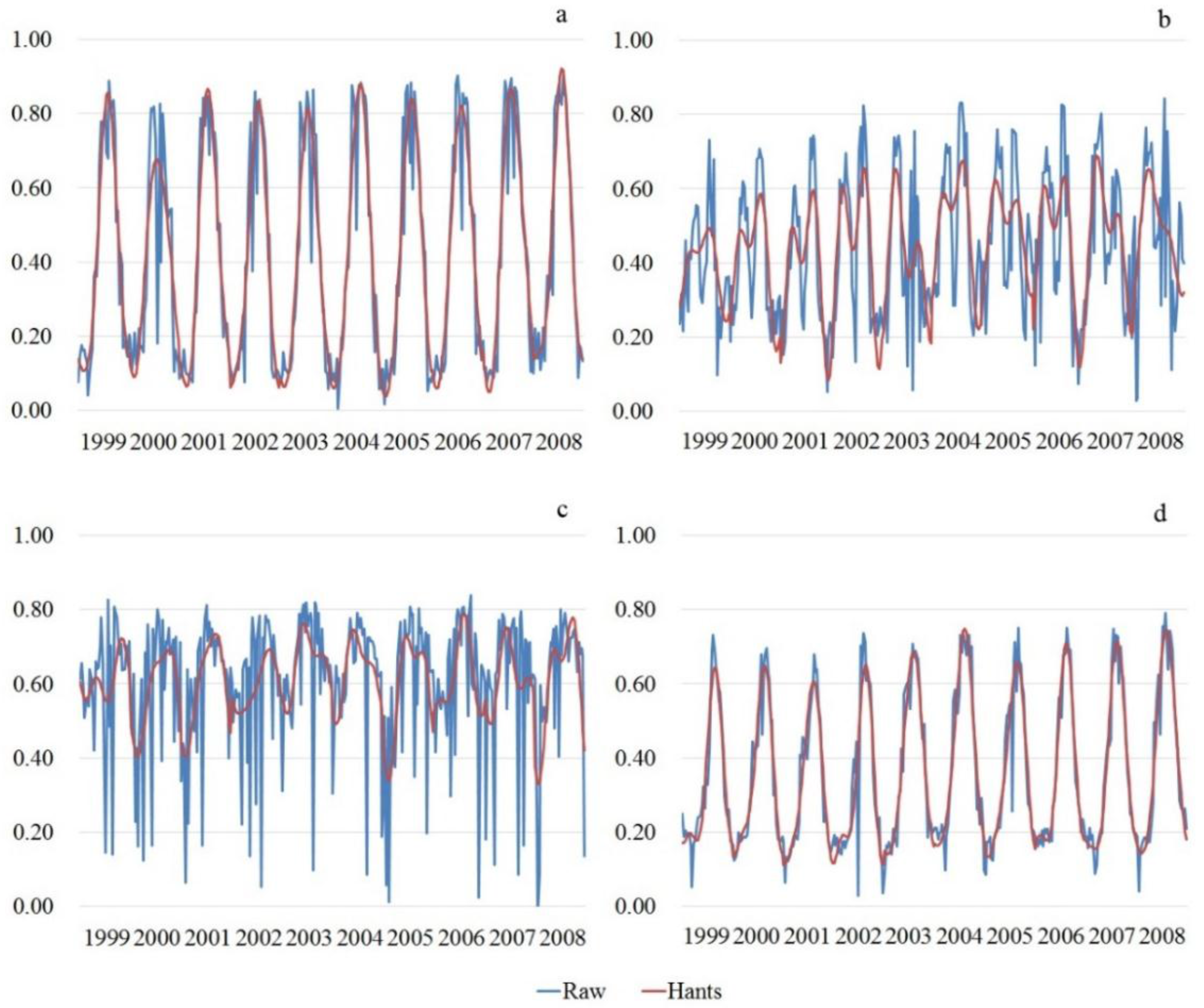
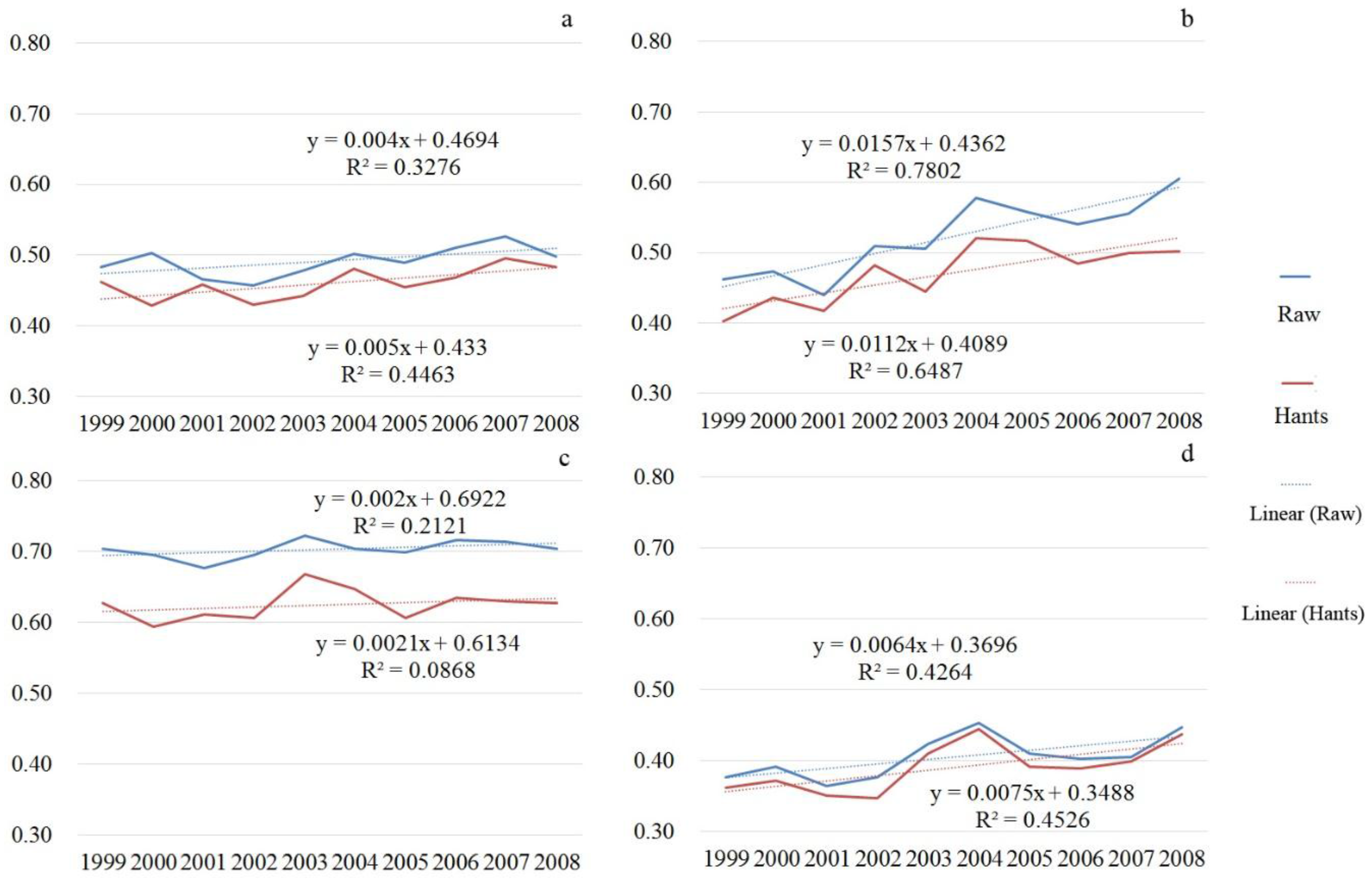
4.3. Limitations and Future Research Directions
5. Conclusions
Acknowledgments
Author Contributions
Conflicts of Interest
References
- Piao, S.L.; Fang, J.Y. Seasonal changes in vegetation activity in response to climate changes in China between 1982 and 1999. Acta Geogr. Sinica 2003, 58, 119–125. (In Chinese) [Google Scholar]
- Hutchinson, J.M.S.; Jacquin, A.; Hutchinson, S.L.; Verbesselt, J. Monitoring vegetation change and dynamics on U.S. Army training lands using satellite image time series analysis. J. Environ. Manage. 2015, 150, 355–366. [Google Scholar] [CrossRef] [PubMed]
- Wu, D.H.; Wu, H.; Zhao, X.; Zhou, T.; Tang, B.J.; Zhao, W.Q.; Jia, K. Evaluation of spatiotemporal variations of global fractional vegetation cover based on GIMMS NDVI data from 1982 to 2011. Remote Sens. 2014, 6, 4217–4239. [Google Scholar] [CrossRef]
- Jalut, G.; Dedoubat, J.J.; Fontugne, M.; Otto, T. Holocene circum-Mediterranean vegetation changes: climate forcing and human impact. Quatern. Int. 2009, 200, 4–18. [Google Scholar] [CrossRef]
- Turner, B.L.; Skole, D.; Sanderson, S.; Fischer, G.; Fresco, L.; Leemans, R. Land-Use and Land-Cover Change, Science/Research Plan; International Geosphere-Biosphere Programme: Wageningen, The Netherlands, 1995. [Google Scholar]
- Bao, G.; Qin, Z.H.; Bao, Y.H.; Zhou, Y.; Li, W.J.; Sanjjav, A. NDVI-based long-term vegetation dynamics and its response to climatic change in the Mongolian Plateau. Remote Sens. 2014, 6, 8337–8358. [Google Scholar] [CrossRef]
- Feurdean, A.; Perşoiu, A.; Tanţău, I.; Stevens, T.; Magyari, E.K.; Onac, B.P.; Marković, S.; Andrič, M.; Connor, S.; Fărcaş, S.; et al. Climate variability and associated vegetation response throughout Central and Eastern Europe (CEE) between 60 and 8 ka. Quat. Sci. Rev. 2014, 106, 206–224. [Google Scholar] [CrossRef]
- Li, Z.Q.; Guo, X.L. Detecting climate effects on vegetation in Northern Mixed Prairie using NOAA AVHRR 1-km time-series NDVI data. Remote Sens. 2012, 4, 120–134. [Google Scholar] [CrossRef]
- Xu, G.; Zhang, H.F.; Chen, B.Z.; Zhang, H.R.; Innes, J.L.; Wang, G.Y.; Yan, J.W.; Zheng, Y.H.; Zhu, Z.C.; Myneni, R.B. Changes in vegetation growth dynamics and relations with climate over China’s landmass from 1982 to 2011. Remote Sens. 2014, 6, 3263–3283. [Google Scholar] [CrossRef]
- Zhou, Y.; Zhang, L.; Fensholt, R.; Wang, K.; Vitkovskaya, I.; Tian, F. Climate contributions to vegetation variations in Central Asian drylands: Pre- and Post- USSR Collapse. Remote Sens. 2015, 7, 2449–2470. [Google Scholar] [CrossRef]
- Myneni, R.B.; Keeling, C.D.; Tucker, C.J.; Asrar, G.; Nemani, R.R. Increased plant growth in the northern high latitudes from 1981 to 1991. Nature 1997, 386, 698–702. [Google Scholar] [CrossRef]
- Myneni, R.B.; Tucker, C.J.; Asrar, G.; Keeling, C.D. Interannual variations in satellite-sensed vegetation index data from 1981 to 1991. J. Geophys. Res. 1998, 103, 6145–6160. [Google Scholar] [CrossRef]
- Kawabata, A.; Ichii, K.; Yamaguchi, Y. Global monitoring of interannual changes in vegetation activities using NDVI and its relationships to temperature and precipitation. Int. J. Remote Sens. 2001, 22, 1377–1382. [Google Scholar] [CrossRef]
- Nemani, R.R.; Keeling, C.D.; Hashimoto, H.; Jolly, W.M.; Piper, S.C.; Tucker, C.J.; Myneni, R.B.; Running, S.W. Climate-driven increases in global terrestrial net primary production from 1982 to 1999. Science 2003, 300, 1560–1563. [Google Scholar] [CrossRef] [PubMed]
- Azzali, S.; Menenti, M. Mapping vegetation-soil-climate complexes in southern Africa using temporal Fourier analysis of NOAA-AVHRR NDVI data. Int. J. Remote Sens. 2000, 21, 973–996. [Google Scholar] [CrossRef]
- Senay, G.B.; Elliott, R.L. Combining AVHRR-NDVI and landuse data to describe temporal and spatial dynamics of vegetation. Forest Ecol. Manag. 2000, 128, 83–91. [Google Scholar] [CrossRef]
- Weiss, E.; Marsh, S.E.; Pfirman, E.S. Application of NOAA-AVHRR NDVI time-series data to assess changes in Saudi Arabia’s rangelands. Int. J. Remote Sens. 2001, 22, 1005–1027. [Google Scholar] [CrossRef]
- Zhou, L.M.; Tucker, C.J.; Kaufmann, R.K.; Slayback, D.; Shabanov, N.V.; Myneni, R.B. Variations in northern vegetation activity inferred from satellite data of vegetation index during 1981 to 1999. J. Geophys. Res. 2001, 106, 20069–20083. [Google Scholar] [CrossRef]
- Pelkey, N.W.; Stoner, C.J.; Caro, T.M. Assessing habitat protection regimes in Tanzania using AVHRR NDVI composites: Comparisons at different spatial and temporal scales. Int. J. Remote Sens. 2003, 24, 2533–2558. [Google Scholar] [CrossRef]
- Stow, D.; Daeschner, S.; Hope, A.; Douglas, D.; Petersen, A.; Myneni, R.; Zhou, L.; Oechel, W. Variability of the seasonally integrated normalized difference vegetation index across the north slope of Alaska in the 1990s. Int. J. Remote Sens. 2003, 24, 1111–1117. [Google Scholar] [CrossRef]
- Yu, F.F.; Price, K.P.; Ellis, J.; Shi, P.J. Response of seasonal vegetation development to climatic variations in Eastern Central Asia. Remote Sens. Environ. 2003, 87, 42–54. [Google Scholar] [CrossRef]
- Gonzalez-Alonso, F.; Cuevas, J.M.; Calle, A.; Casanova, J.L.; Romo, A. Spanish vegetation monitoring during the period 1987–2001 using NOAA-AVHRR images. Int. J. Remote Sens. 2004, 25, 3–6. [Google Scholar] [CrossRef]
- Tarnavsky, E.; Garrigues, S.; Brown, M.E. Multiscale geostatistical analysis of AVHRR, SPOT-VGT, and MODIS global NDVI products. Remote Sens. Environ. 2008, 112, 535–549. [Google Scholar] [CrossRef]
- Fensholt, R.; Proud, S.R. Evaluation of Earth Observation based global long term vegetation trends—Comparing GIMMS and MODIS global NDVI time series. Remote Sens. Environ. 2012, 119, 131–147. [Google Scholar] [CrossRef]
- Peng, J.; Liu, Y.H.; Shen, H.; Han, Y.N.; Pan, Y.J. Vegetation coverage change and associated driving forces in mountain areas of Northwestern Yunnan, China using RS and GIS. Environ. Monit. Assess. 2012, 184, 4787–4798. [Google Scholar] [CrossRef] [PubMed]
- Ichii, K.; Kawabata, A.; Yamaguchi, Y. Global correlation analysis for NDVI and climatic variables and NDVI trends: 1982–1990. Int. J. Remote Sens. 2002, 23, 3873–3878. [Google Scholar] [CrossRef]
- Shabanov, N.V.; Zhou, L.M.; Knyazikhin, Y.; Myneni, R.B.; Tucker, C.J. Analysis of interannual changes in northern vegetation activity observed in AVHRR data from 1981 to 1994. IEEE Trans. Geosci. Remote Sens. 2002, 40, 115–130. [Google Scholar] [CrossRef]
- Gong, D.Y.; Ho, C.H. Detection of large-scale climate signals in spring vegetation index (normalized difference vegetation index) over the Northern Hemisphere. J. Geophys. Res. 2003. [Google Scholar] [CrossRef]
- Gong, D.Y.; Shi, P.J. Northern hemispheric NDVI variations associated with large-scale climate indices in spring. Int. J. Remote Sens. 2003, 24, 2559–2566. [Google Scholar] [CrossRef]
- Zhou, L.; Kaufmann, R.K.; Tian, Y.; Myneni, R.B.; Tucker, C.J. Relation between interannual variations in satellite measures of northern forest greenness and climate between 1982 and 1999. J. Geophys. Res. 2003. [Google Scholar] [CrossRef]
- Paruelo, J.M.; Lauenroth, W.K. Interannual variability of NDVI and its relationship to climate for North American shrublands and grasslands. J. Biogeogr. 1998, 25, 721–733. [Google Scholar] [CrossRef]
- Yang, L.M.; Wylie, B.K.; Tieszen, L.L.; Reed, B.C. An analysis of relationships among climate forcing and time-integrated NDVI of grasslands over the U.S. northern and central Great Plains. Remote Sens. Environ. 1998, 65, 25–37. [Google Scholar] [CrossRef]
- Ji, L.; Peters, A.J. A spatial regression procedure for evaluating the relationship between AVHRR-NDVI and climate in the northern Great Plains. Int. J. Remote Sens. 2004, 25, 297–311. [Google Scholar] [CrossRef]
- Peng, J.; Liu, Z.H.; Liu, Y.H.; Wu, J.S.; Han, Y.N. Trend analysis of vegetation dynamics in Qinghai-Tibet Plateau using Hurst Exponent. Ecol. Indic. 2012, 14, 28–39. [Google Scholar] [CrossRef]
- Lu, D.S.; Xu, X.F.; Tian, H.Q.; Moran, E.; Zhao, M.S.; Running, S. The effects of urbanization on net primary productivity in southeastern China. Environ. Manage. 2010, 46, 404–410. [Google Scholar] [CrossRef] [PubMed]
- Xu, C.; Liu, M.; An, S.; Chen, J.M.; Yan, P. Assessing the impact of urbanization on regional net primary productivity in Jiangyin County, China. J. Environ. Manage. 2007, 85, 597–606. [Google Scholar] [CrossRef] [PubMed]
- Peng, J.; Wu, J.S.; Yin, H.; Li, Z.G.; Chang, Q.; Mu, T.L. Rural land use change during1986–2002 in Lijiang, China, based on remote sensing and GIS data. Sensors 2008, 8, 8201–8223. [Google Scholar] [CrossRef]
- Liu, Y.X.; Wang, Y.L.; Peng, J.; Du, Y.Y.; Liu, X.F.; Li, S.S.; Zhang, D.H. Correlations between urbanization and vegetation degradation across the world’s metropolises using DMSP/OLS nighttime light data. Remote Sens. 2015, 7, 2067–2088. [Google Scholar] [CrossRef]
- Chen, J.; Jönsson, P.; Tamura, M.; Gu, Z.; Matsushita, B.; Eklundh, L. A simple method for reconstructing a high-quality NDVI time-series data set based on the Savitzky–Golay filter. Remote Sens. Environ. 2004, 91, 332–344. [Google Scholar] [CrossRef]
- Cihlar, J.; Ly, H.; Li, Z.Q.; Chen, J.; Pokrant, H.; Huang, F.T. Multitemporal, multichannel AVHRR data sets for land biosphere studies—Artifacts and corrections. Remote Sens. Environ. 1997, 60, 35–57. [Google Scholar] [CrossRef]
- Gutman, G.G. Vegetation indices from AVHRR: An update and future prospects. Remote Sens. Environ. 1991, 35, 121–136. [Google Scholar] [CrossRef]
- Jin, Z.; Xu, B. A novel compound smoother-RMMEH to reconstruct MODIS NDVI time series. IEEE Geosci. Remote Sens. 2013, 10, 942–946. [Google Scholar]
- Ren, J.; Chen, Z.; Zhou, Q.; Tang, H. Regional yield estimation for winter wheat with MODIS-NDVI data in Shandong, China. Int. J. Appl. Earth Obs. 2008, 10, 403–413. [Google Scholar] [CrossRef]
- Brooks, E.B.; Thomas, V.A.; Wynne, R.H.; Coulston, J.W. Fitting the multitemporal curve: A Fourier series approach to the missing data problem in remote sensing analysis. IEEE Trans. Geosci. Remote Sens. 2012, 50, 3340–3353. [Google Scholar] [CrossRef]
- Beck, P.S.A.; Atzberger, C.; Høgda, K.A.; Johansen, B.; Skidmore, A.K. Improved monitoring of vegetation dynamics at very high latitudes: A new method using MODIS NDVI. Remote Sens. Environ. 2006, 100, 321–334. [Google Scholar] [CrossRef]
- Jönsson, P.; Eklundh, L. Seasonality extraction by function fitting to time-series of satellite sensor data. IEEE Trans Geosci. Remote Sens. 2002, 40, 1824–1832. [Google Scholar] [CrossRef]
- Zhou, J.; Li, J.; Menenti, M. Reconstruction of global MODIS NDVI time series: Performance of Harmonic Analysis of Time Series (HANTS). Remote Sens. Environ. 2015, 163, 217–228. [Google Scholar] [CrossRef]
- National Geophysical Data Center. The Defense Meteorological Satellite Program (DMSP)/Operational Line-Scan System (OLS) nighttime stable light data (NTL) data (1999–2008). Available online: http://www.ngdc.noaa.gov/dmsp/downloadV4composites.html.
- He, C.Y.; Shi, P.J.; Li, J.G.; Chen, J.; Pan, Y.Z.; Li, J.; Zhuo, L.; Ichinose, T. Restoring urbanization process in China in the 1990s by using non-radiance-calibrated DMSP/OLS nighttime light imagery and statistical data. Chin. Sci. Bull. 2006, 51, 1614–1620. [Google Scholar] [CrossRef]
- Fensholt, R.; Horion, S.; Tagesson, T.; Ehammer, A.; Ivits, E.; Rasmussen, K. Global-scale mapping of changes in ecosystem functioning from earth observation-based trends in total and recurrent vegetation. Global Ecol. Biogeogr. 2015, 24, 1003–1017. [Google Scholar] [CrossRef]
- Tottrup, C.; Rasmussen, M.S. Mapping long-term changes in savannah crop productivity in Senegal through trend analysis of time series of remote sensing data. Agr. Ecosyst. Environ. 2004, 103, 545–560. [Google Scholar] [CrossRef]
- Herrmann, S.M.; Anyamba, A.; Tucker, C.J. Recent trends in vegetation dynamics in the African Sahel and their relationship to climate. Global Environ. Chang. 2005, 15, 394–404. [Google Scholar]
- Camberlin, P.; Martiny, N.; Philippon, N.; Richard, Y. Determinants of the interannual relationships between remote sensed photosynthetic activity and rainfall in tropical Africa. Remote Sens. Environ. 2007, 106, 199–216. [Google Scholar] [CrossRef]
- Hansen, P.M.; Schjoerring, J.K. Reflectance measurement of canopy biomass and nitrogen status in wheat crops using normalized difference vegetation indices and partial least squares regression. Remote Sens. Environ. 2003, 86, 542–553. [Google Scholar]
- Li, J.X.; Li, C.; Zhu, F.G.; Song, C.H.; Wu, J.G. Spatiotemporal pattern of urbanization in Shanghai, China between 1989 and 2005. Landsc. Ecol. 2013, 28, 1545–1565. [Google Scholar] [CrossRef]
- Su, S.L.; Ma, X.Y.; Xiao, R. Agricultural landscape pattern changes in response to urbanization at ecoregional scale. Ecol. Indic. 2014, 40, 10–18. [Google Scholar] [CrossRef]
- He, C.Y.; Liu, Z.F.; Tian, J.; Ma, Q. Urban expansion dynamics and natural habitat loss in China: A multiscale landscape perspective. Global Change Biol. 2014, 20, 2886–2902. [Google Scholar] [CrossRef] [PubMed]
- Su, S.L.; Wang, Y.P.; Luo, F.H.; Mai, G.C.; Pu, J. Peri-urban vegetated landscape pattern changes in relation to socioeconomic development. Ecol. Indic. 2014, 46, 477–486. [Google Scholar] [CrossRef]
- Zhou, J.H.; Yu, B.L.; Qin, J. Multi-level spatial analysis for change detection of urban vegetation at individual tree scale. Remote Sens. 2014, 6, 9086–9103. [Google Scholar] [CrossRef]
- Evrendilek, F.; Gulbeyaz, O. Deriving vegetation dynamics of natural terrestrial ecosystems from MODIS NDVI/EVI data over Turkey. Sensors 2008, 8, 5270–5302. [Google Scholar] [CrossRef]
- Caccamo, G.; Chisholm, L.A.; Bradstock, R.A.; Puotinen, M.L. Assessing the sensitivity of MODIS to monitor drought in high biomass ecosystems. Remote Sens. Environ. 2011, 115, 2626–2639. [Google Scholar] [CrossRef]
- Hwang, T.; Song, C.H.; Bolstad, P.V.; Band, L.E. Downscaling real-time vegetation dynamics by fusing multi-temporal MODIS and Landsat NDVI in topographically complex terrain. Remote Sens. Environ. 2011, 115, 2499–2512. [Google Scholar] [CrossRef]
- Huete, A.; Didan, K.; Miura, T.; Rodriguez, E.P.; Gao, X.; Ferreira, L.G. Overview of the radiometric and biophysical performance of the MODIS vegetation indices. Remote Sens. Environ. 2002, 83, 195–213. [Google Scholar] [CrossRef]
- An, Y.Z.; Gao, W.; Gao, Z.Q.; Liu, C.S.; Shi, R.H. Trend analysis for evaluating the consistency of Terra MODIS and SPOT VGT NDVI time series products in China. Front. Earth Sci. 2015, 9, 125–136. [Google Scholar] [CrossRef]
- Jarlan, L.; Mangiarotti, S.; Mougin, E.; Mazzega, P.; Hiernaux, P.; Le Dantec, V. Assimilation of SPOT/VEGETATION NDVI data into a sahelian vegetation dynamics model. Remote Sens. Environ. 2008, 112, 1381–1394. [Google Scholar] [CrossRef]
- Sun, Z.D.; Chang, N.B.; Opp, C. Using SPOT-VGT NDVI as a successive ecological indicator for understanding the environmental implications in the Tarim River Basin, China. J. Appl. Remote Sens. 2010. [Google Scholar] [CrossRef]
- Höpfner, C.; Scherer, D. Analysis of vegetation and land cover dynamics in north-western Morocco during the last decade using MODIS NDVI time series data. Biogeosciences 2011, 8, 3359–3373. [Google Scholar] [CrossRef]
- Geng, L.; Ma, M.; Wang, X.; Yu, W.; Jia, S.; Wang, H. Comparison of eight techniques for reconstructing multi-satellite sensor time-series NDVI data sets in the Heihe River Basin, China. Remote Sens. 2014, 6, 2014–2049. [Google Scholar] [CrossRef]
© 2015 by the authors; licensee MDPI, Basel, Switzerland. This article is an open access article distributed under the terms and conditions of the Creative Commons Attribution license (http://creativecommons.org/licenses/by/4.0/).
Share and Cite
Peng, J.; Li, Y.; Tian, L.; Liu, Y.; Wang, Y. Vegetation Dynamics and Associated Driving Forces in Eastern China during 1999–2008. Remote Sens. 2015, 7, 13641-13663. https://doi.org/10.3390/rs71013641
Peng J, Li Y, Tian L, Liu Y, Wang Y. Vegetation Dynamics and Associated Driving Forces in Eastern China during 1999–2008. Remote Sensing. 2015; 7(10):13641-13663. https://doi.org/10.3390/rs71013641
Chicago/Turabian StylePeng, Jian, You Li, Lu Tian, Yanxu Liu, and Yanglin Wang. 2015. "Vegetation Dynamics and Associated Driving Forces in Eastern China during 1999–2008" Remote Sensing 7, no. 10: 13641-13663. https://doi.org/10.3390/rs71013641
APA StylePeng, J., Li, Y., Tian, L., Liu, Y., & Wang, Y. (2015). Vegetation Dynamics and Associated Driving Forces in Eastern China during 1999–2008. Remote Sensing, 7(10), 13641-13663. https://doi.org/10.3390/rs71013641







